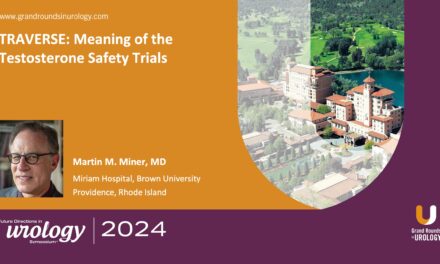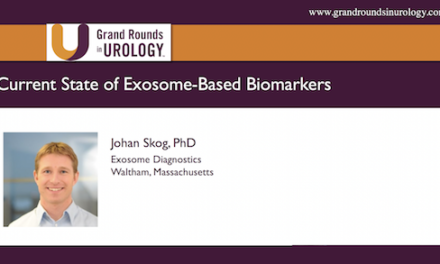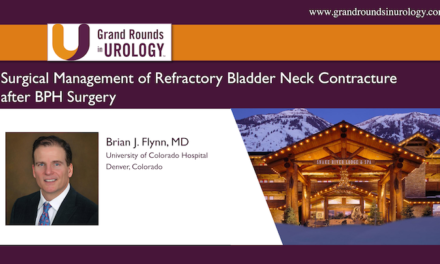This issue of Grand Rounds in Urology provides a thorough review of available biomarkers and genomic tests for diagnosing clinically significant prostate cancer. It also discusses the challenges, implementation, and costs associated with these tests, and offers an algorithm incorporating the latest data for clinical use.
Keywords:
prostate carcinoma, biomarkers, PSA screening, antiandrogens, biopsy, aggressive prostate cancer
Faculty:
Medical Editor:
E. David Crawford, MD
Professor of Surgery, Urology, and Radiation Oncology Head, Urologic Oncology
E. David Crawford Endowed Chair in Urologic Oncology
University of Colorado, Denver
Aurora, Colorado
Faculty:
Paul Arangua
Research Assistant
University of Colorado, Denver
Aurora, CO
Salvatore P. Catarinicchia, MD
Surgery/Urology Resident
University of Colorado, Denver
Aurora, Colorado
John Hoenemeyer, MD
Urologic Oncology Research Fellow
University of Colorado, Denver
Aurora, CO
Robert E. Donohue, MD
Professor, Department of Surgery
University of Colorado, Denver
Aurora, CO
L. Michael Glode, MD
Professor, Division of Medical Oncology
Robert Rifkin Chair for Prostate Cancer Research
University of Colorado, Denver
Aurora, CO
Michael Maccini, MD
Urology Resident
University of Colorado, Denver
Aurora, CO
Priya N. Werahera, PhD
Research Assistant Professor
University of Colorado, Denver
Aurora, CO
Nick Westfall, MD
Urology Resident
University of Colorado, Denver
Aurora, CO
Cole Wiedel, MD
General Surgeon
Aurora, CO
References:
1. Cooperberg MR, Carroll PR, Klotz L. Active surveillance for prostate cancer: progress and promise. J Clin Oncol Off J Am Soc Clin Oncol. 2011 Sep 20;29(27):3669–76.
2. Final Recommendation Statement: Prostate Cancer: Screening – US Preventive Services Task Force [Internet]. [cited 2016 Aug 15]. Available from: http://www.uspreventiveservicestaskforce. org/Page/Document/ RecommendationStatementFinal/prostatecancer- screening
3. Carter HB, Peter Albertsen, Michael J. Barry. Detection of Prostate Cancer: American Urological Association [Internet]. [cited 2016 Sep 8]. Available from: https://www. auanet.org/education/guidelines/prostatecancer- detection.cfm
4. Aslani A, Minnillo BJ, Johnson B, Cherullo EE, Ponsky LE, Abouassaly R. The impact of recent screening recommendations on prostate cancer screening in a large health care system. J Urol. 2014 Jun;191(6):1737–42.
5. Biomarkers Definitions Working Group. Biomarkers and surrogate endpoints: preferred definitions and conceptual framework. Clin Pharmacol Ther. 2001 Mar;69(3):89–95.
6. Tonry CL, Leacy E, Raso C, Finn SP, Armstrong J, Pennington SR. The Role of Proteomics in Biomarker Development for Improved Patient Diagnosis and Clinical Decision Making in Prostate Cancer. Diagn Basel Switz. 2016;6(3).
7. Siegel R, Naishadham D, Jemal A. Cancer statistics, 2013. CA Cancer J Clin. 2013 Jan 1;63(1):11–30.
8. Siegel RL, Miller KD, Jemal A. Cancer statistics, 2016. CA Cancer J Clin. 2016 Feb;66(1):7–30.
9. Shariat SF, Canto EI, Kattan MW, Slawin KM. Beyond prostate-specific antigen: new serologic biomarkers for improved diagnosis and management of prostate cancer. Rev Urol. 2004;6(2):58–72.
10. Prostate-Specific Antigen (PSA) Test [Internet]. National Cancer Institute. [cited 2016 Sep 2]. Available from: http://www.cancer. gov/types/prostate/psa-fact-sheet
11. Andriole GL, Crawford ED, Grubb RL, Buys SS, Chia D, Church TR, et al. Prostate cancer screening in the randomized Prostate, Lung, Colorectal, and Ovarian Cancer Screening Trial: mortality results grandroundsinurology.com 11 after 13 years of follow-up. J Natl Cancer Inst. 2012 Jan 18;104(2):125–32.
12. Schröder FH, Hugosson J, Roobol MJ, Tammela TLJ, Ciatto S, Nelen V, et al. Prostate-Cancer Mortality at 11 Years of Follow-up. N Engl J Med. 2012 Mar 15;366(11):981–90.
13. Crawford ED, Grubb R, Black A, Andriole GL, Chen M-H, Izmirlian G, et al. Comorbidity and Mortality Results From a Randomized Prostate Cancer Screening Trial. J Clin Oncol. 2010 Nov 1;JCO.2010.30.5979.
14. Crawford ED, Moul JW, Rove KO, Pettaway CA, Lamerato LE, Hughes A. Prostate- specific antigen 1.5-4.0 ng/mL: a diagnostic challenge and danger zone. BJU Int. 2011 Dec;108(11):1743–9.
15. Mikolajczyk SD, Millar LS, Wang TJ, Rittenhouse HG, Marks LS, Song W, et al. A precursor form of prostate-specific antigen is more highly elevated in prostate cancer compared with benign transition zone prostate tissue. Cancer Res. 2000 Feb 1;60(3):756–9.
16. The benefits of phi | Prostate Health Index – US [Internet]. [cited 2016 Aug 17]. Available from: http://prostatehealthindex. us/2014/02/19/the-benefits-of-phi/
17. Catalona WJ, Partin AW, Sanda MG, Wei JT, Klee GG, Bangma CH, et al. A multicenter study of [-2]pro-prostate specific antigen combined with prostate specific antigen and free prostate specific antigen for prostate cancer detection in the 2.0 to 10.0 ng/ml prostate specific antigen range. J Urol. 2011 May;185(5):1650–5.
18. Bruzzese D, Mazzarella C, Ferro M, Perdonà S, Chiodini P, Perruolo G, et al. Prostate health index vs percent free prostate- specific antigen for prostate cancer detection in men with “gray” prostate-specific antigen levels at first biopsy: systematic review and meta-analysis. Transl Res J Lab Clin Med. 2014 Dec;164(6):444–51.
19. Carroll PR, Parsons JK, Andriole G, Bahnson RR, Castle EP, Catalona WJ, et al. NCCN Guidelines Insights: Prostate Cancer Early Detection, Version 2.2016. J Natl Compr Cancer Netw JNCCN. 2016 May;14(5):509–19.
20. Darson MF, Pacelli A, Roche P, Rittenhouse HG, Wolfert RL, Young CY, et al. Human glandular kallikrein 2 (hK2) expression in prostatic intraepithelial neoplasia and adenocarcinoma: a novel prostate cancer marker. Urology. 1997 Jun;49(6):857–62.
21. Tremblay RR, Deperthes D, Têtu B, Dubé JY. Immunohistochemical study suggesting a complementary role of kallikreins hK2 and hK3 (prostate-specific antigen) in the functional analysis of human prostate tumors. Am J Pathol. 1997 Feb;150(2):455–9.
22. What is the 4Kscore Test? | 4Kscore Test [Internet]. [cited 2016 Aug 29]. Available from: http://4kscore.com/4kscore-test-forphysicians/ what-is-the-4kscore-test/
23. Stattin P, Vickers AJ, Sjoberg DD, Johansson R, Granfors T, Johansson M, et al. Improving the Specificity of Screening for Lethal Prostate Cancer Using Prostate-specific Antigen and a Panel of Kallikrein Markers: A Nested Case-Control Study. Eur Urol. 2015 Aug;68(2):207–13.
24. Parekh DJ, Punnen S, Sjoberg DD, Asroff SW, Bailen JL, Cochran JS, et al. A multiinstitutional prospective trial in the USA confirms that the 4Kscore accurately identifies men with high-grade prostate cancer. Eur Urol. 2015 Sep;68(3):464–70.
25. Chevli KK, Duff M, Walter P, Yu C, Capuder B, Elshafei A, et al. Urinary PCA3 as a predictor of prostate cancer in a cohort of 3,073 men undergoing initial prostate biopsy. J Urol. 2014 Jun;191(6):1743–8.
26. Konety B, Zappala SM, Parekh DJ, Osterhout D, Schock J, Chudler RM, et al. The 4Kscore® Test Reduces Prostate Biopsy Rates in Community and Academic Urology Practices. Rev Urol. 2015;17(4):231–40.
27. Van Neste L, Hendriks RJ, Dijkstra S, Trooskens G, Cornel EB, Jannink SA, et al. Detection of High-grade Prostate Cancer Using a Urinary Molecular Biomarker- Based Risk Score. Eur Urol. 2016 Apr 20.
28. Leyten GHJM, Hessels D, Smit FP, Jannink SA, de Jong H, Melchers WJG, et al. Identification of a Candidate Gene Panel for the Early Diagnosis of Prostate Cancer. Clin Cancer Res Off J Am Assoc Cancer Res. 2015 Jul 1;21(13):3061–70.
29. Bussemakers MJ, van Bokhoven A, Verhaegh GW, Smit FP, Karthaus HF, Schalken JA, et al. DD3: a new prostate-specific gene, highly overexpressed in prostate cancer. Cancer Res. 1999 Dec 1;59(23):5975–9.
30. Hessels D, Klein Gunnewiek JMT, van Oort I, Karthaus HFM, van Leenders GJL, van Balken B, et al. DD3(PCA3)-based molecular urine analysis for the diagnosis of prostate cancer. Eur Urol. 2003 Jul;44(1):8-15-16.
31. PCA3 utility | PCA3.org – Healthcare Professionals [Internet]. [cited 2016 Aug 26]. Available from: http://www.pca3.org/pro/ pca3/pca3-utility-0
32. Marks LS, Fradet Y, Deras IL, Blase A, Mathis J, Aubin SMJ, et al. PCA3 molecular urine assay for prostate cancer in men undergoing repeat biopsy. Urology. 2007 Mar;69(3):532–5.
33. Okcelik S, Soydan H, Ates F, Berber U, Saygin H, Sonmez G, et al. Evaluation of PCA3 and multiparametric MRI’s: collective benefits before deciding initial prostate biopsy for patients with PSA level between 3-10ng/mL. Int Braz J Urol Off J Braz Soc Urol. 2016 Jun;42(3):449–55.
34. Slaughter DP, Southwick HW, Smejkal W. Field cancerization in oral stratified squamous epithelium; clinical implications of multicentric origin. Cancer. 1953 Sep;6(5):963–8.
35. Taneja SS. The American Urological Association (AUA) Optimal Techniques of Prostate Biopsy and Specimen Handling. 2013. [Internet]. 2013. Available from: https:// www.auanet.org/common/pdf/education/ clinical-guidance/Prostate-Biopsy-White- Paper.pdf
36. Heichman KA, Warren JD. DNA methylation biomarkers and their utility for solid cancer diagnostics. Clin Chem Lab Med. 2012 Oct 1;50(10):1707–21.
37. Van Neste L, Herman JG, Otto G, Bigley JW, Epstein JI, Van Criekinge W. The epigenetic promise for prostate cancer diagnosis. The Prostate. 2012 Aug 1;72(11):1248–61.
38. Van Neste L, Bigley J, Toll A, Otto G, Clark J, Delrée P, et al. A tissue biopsy-based epigenetic multiplex PCR assay for prostate cancer detection. BMC Urol. 2012;12:16.
39. Minciu R, Dumache R, Gheorghe P, Daminescu L, Rogobete AF, Ionescu D. Molecular Diagnostic of Prostate Cancer From Body Fluids Using Methylation-Specific PCR (MS-PCR) Method. Clin Lab. 2016;62(6):1183–6.
40. Stewart GD, Van Neste L, Delvenne P, Delrée P, Delga A, McNeill SA, et al. Clinical utility of an epigenetic assay to detect occult prostate cancer in histopathologically negative biopsies: results of the MATLOC study. J Urol. 2013 Mar;189(3):1110–6.
41. Partin AW, Van Neste L, Klein EA, Marks LS, Gee JR, Troyer DA, et al. Clinical validation of an epigenetic assay to predict negative histopathological results in repeat prostate biopsies. J Urol. 2014 Oct;192(4):1081–7.
42. Van Neste L, Partin AW, Stewart GD, Epstein JI, Harrison DJ, Van Criekinge W. Risk score predicts high-grade prostate cancer in DNA-methylation positive, histopathologically negative biopsies. The Prostate. 2016 Sep 1;76(12):1078–87. 12 grandroundsinurology.com
43. Wojno KJ, Costa FJ, Cornell RJ, Small JD, Pasin E, Van Criekinge W, et al. Reduced Rate of Repeated Prostate Biopsies Observed in ConfirmMDx Clinical Utility Field Study. Am Health Drug Benefits. 2014 May;7(3):129–34.
44. Crawford ED, Ventii K, Shore ND. New biomarkers in prostate cancer. Oncol Williston Park N. 2014 Feb;28(2):135–42.
45. Falzarano SM, Ferro M, Bollito E, Klein EA, Carrieri G, Magi-Galluzzi C. Novel biomarkers and genomic tests in prostate cancer: a critical analysis. Minerva Urol E Nefrol Ital J Urol Nephrol. 2015 Sep;67(3):211–31.
46. Chaux A, Peskoe SB, Gonzalez-Roibon N, Schultz L, Albadine R, Hicks J, et al. Loss of PTEN expression is associated with increased risk of recurrence after prostatectomy for clinically localized prostate cancer. Mod Pathol Off J U S Can Acad Pathol Inc. 2012 Nov;25(11):1543–9.
47. Reid AHM, Attard G, Ambroisine L, Fisher G, Kovacs G, Brewer D, et al. Molecular characterisation of ERG, ETV1 and PTEN gene loci identifies patients at low and high risk of death from prostate cancer. Br J Cancer. 2010 Feb 16;102(4):678–84.
48. Yoshimoto M, Joshua AM, Cunha IW, Coudry RA, Fonseca FP, Ludkovski O, et al. Absence of TMPRSS2:ERG fusions and PTEN losses in prostate cancer is associated with a favorable outcome. Mod Pathol Off J U S Can Acad Pathol Inc. 2008 Dec;21(12):1451–60.
49. Sehn JK, Spencer DH, Pfeifer JD, Bredemeyer AJ, Cottrell CE, Abel HJ, et al. Occult Specimen Contamination in Routine Clinical Next-Generation Sequencing Testing. Am J Clin Pathol. 2015 Oct 1;144(4):667–74.
50. Wojno K, Hornberger J, Schellhammer P, Dai M, Morgan T. The clinical and economic implications of specimen provenance complications in diagnostic prostate biopsies. J Urol. 2015 Apr;193(4):1170–7.
51. Knezevic D, Goddard AD, Natraj N, Cherbavaz DB, Clark-Langone KM, Snable J, et al. Analytical validation of the Oncotype DX prostate cancer assay – a clinical RT-PCR assay optimized for prostate needle biopsies. BMC Genomics. 2013;14:690.
52. Klein EA, Cooperberg MR, Magi-Galluzzi C, Simko JP, Falzarano SM, Maddala T, et al. A 17-gene assay to predict prostate cancer aggressiveness in the context of Gleason grade heterogeneity, tumor multifocality, and biopsy undersampling. Eur Urol. 2014 Sep;66(3):550–60.
53. Cullen J, Rosner IL, Brand TC, Zhang N, Tsiatis AC, Moncur J, et al. A Biopsy-based 17-gene Genomic Prostate Score Predicts Recurrence After Radical Prostatectomy and Adverse Surgical Pathology in a Racially Diverse Population of Men with Clinically Low- and Intermediate-risk Prostate Cancer. Eur Urol. 2015 Jul;68(1):123–31.
54. Magi-Galluzzi C, Maddala T, Falzarano SM, Cherbavaz DB, Zhang N, Knezevic D, et al. Gene expression in normal-appearing tissue adjacent to prostate cancers are predictive of clinical outcome: evidence for a biologically meaningful field effect. Oncotarget. 2016 Apr 22.
55. Shipitsin M, Small C, Choudhury S, Giladi E, Friedlander S, Nardone J, et al. Identification of proteomic biomarkers predicting prostate cancer aggressiveness and lethality despite biopsy-sampling error. Br J Cancer. 2014 Sep 9;111(6):1201–12.
56. Blume-Jensen P, Berman DM, Rimm DL, Shipitsin M, Putzi M, Nifong TP, et al. Development and Clinical Validation of an In Situ Biopsy-Based Multimarker Assay for Risk Stratification in Prostate Cancer. Am Assoc Cancer Res [Internet]. 2015 Mar 2 [cited 2016 Sep 8]; Available from: http:// clincancerres.aacrjournals.org/content/early/ 2015/04/22/1078-0432.CCR-14-2603
57. Shipitsin M, Small C, Giladi E, Siddiqui S, Choudhury S, Hussain S, et al. Automated quantitative multiplex immunofluorescence in situ imaging identifies phospho-S6 and phospho-PRAS40 as predictive protein biomarkers for prostate cancer lethality. Proteome Sci. 2014;12:40.
58. Cooperberg MR, Simko JP, Cowan JE, Reid JE, Djalilvand A, Bhatnagar S, et al. Validation of a cell-cycle progression gene panel to improve risk stratification in a contemporary prostatectomy cohort. J Clin Oncol Off J Am Soc Clin Oncol. 2013 Apr 10;31(11):1428–34.
59. Cuzick J, Swanson GP, Fisher G, Brothman AR, Berney DM, Reid JE, et al. Prognostic value of an RNA expression signature derived from cell cycle proliferation genes in patients with prostate cancer: a retrospective study. Lancet Oncol. 2011 Mar;12(3):245–55.
60. Crawford ED, Scholz MC, Kar AJ, Fegan JE, Haregewoin A, Kaldate RR, et al. Cell cycle progression score and treatment decisions in prostate cancer: results from an ongoing registry. Curr Med Res Opin. 2014 Jun;30(6):1025–31.
61. Understanding The Prolaris ScoreTM | Prolaris [Internet]. [cited 2016 Sep 1]. Available from: https://prolaris.com/prolaris- for-physicians/about-prolaris/understanding- the-prolaris-score/
62. Karnes RJ, Bergstralh EJ, Davicioni E, Ghadessi M, Buerki C, Mitra AP, et al. Validation of a genomic classifier that predicts metastasis following radical prostatectomy in an at risk patient population. J Urol. 2013 Dec;190(6):2047–53.
63. Badani K, Thompson DJS, Buerki C, Davicioni E, Garrison J, Ghadessi M, et al. Impact of a genomic classifier of metastatic risk on postoperative treatment recommendations for prostate cancer patients: a report from the DECIDE study group. Oncotarget. 2013 Sep 8;4(4):600–9.
64. Badani KK, Thompson DJ, Brown G, Holmes D, Kella N, Albala D, et al. Effect of a genomic classifier test on clinical practice decisions for patients with high-risk prostate cancer after surgery. BJU Int. 2015 Mar;115(3):419–29.
65. Klein EA, Haddad Z, Yousefi K, Lam LLC, Wang Q, Choeurng V, et al. Decipher Genomic Classifier Measured on Prostate Biopsy Predicts Metastasis Risk. Urology. 2016 Apr;90:148–52.
66. Simon R. Development and validation of therapeutically relevant multi-gene biomarker classifiers. J Natl Cancer Inst. 2005 Jun 15;97(12):866–7.
67. Antonarakis ES, Lu C, Wang H, Luber B, Nakazawa M, Roeser JC, et al. AR-V7 and Resistance to Enzalutamide and Abiraterone in Prostate Cancer. N Engl J Med. 2014 Sep 11;371(11):1028–38.
68. Scher HI, Lu D, Schreiber NA, et al. ASsociation of ar-v7 on circulating tumor cells as a treatment-specific biomarker with outcomes and survival in castration-resistant prostate cancer. JAMA Oncol [Internet]. 2016 Jun 4 [cited 2016 Sep 8]; Available from: http:// dx.doi.org/10.1001/jamaoncol.2016.1828
69. Sarwar M, Semenas J, Miftakhova R, Simoulis A, Robinson B, Wingren AG, et al. Targeted suppression of AR-V7 using PIP5K1α inhibitor overcomes enzalutamide resistance in prostate cancer cells. Oncotarget. 2016 Aug 31;
70. Hearn JWD, AbuAli G, Reichard CA, Reddy CA, Magi-Galluzzi C, Chang K-H, et al. HSD3B1 and resistance to androgen-deprivation therapy in prostate cancer: a retrospective, multicohort study. Lancet Oncol [Internet]. 2016 Aug [cited 2016 Sep 8]; Available from: http://linkinghub.elsevier. com/retrieve/pii/S1470204516302273 grandroundsinurology.com
71. Siegel RL, Miller KD, Jemal A. Cancer Statistics, 2017. CA Cancer J Clin 2017;67:7-30.
72. Sakr WA, Grignon DJ, Crissman JD, Heilbrun LK, Cassin BJ, Pontes JJ, et al. High grade prostatic intraepithelial neoplasia (HGPIN) and prostatic adenocarcinoma between the ages of 20-69: an autopsy study of 249 cases. In Vivo 1994;8:439-43.
73. Lubeck DP, Grossfeld GD, Carroll PR. A review of measurement of patient preferences for treatment outcomes after prostate cancer. Urology 2002;60:72-7.
74. Meng MV, Elkin EP, Harlan SR, Mehta SS, Lubeck DP, Carroll PR. Predictors of treatment after initial surveillance in men with prostate cancer: results from CaPSURE. J Urol 2003;170:2279-83.
75. Crawford ED, Rosenberg MT, Partin AW, Cooperberg MR, Maccini M, Loeb S, et al. An Approach Using PSA Levels of 1.5 ng/mL as the Cutoff for Prostate Cancer Screening in Primary Care. Urology 2016;96:116-20.
76. Crawford ED, Moul JW, Rove KO, Pettaway CA, Lamerato LE, Hughes A. Prostate- specific antigen 1.5-4.0 ng/mL: a diagnostic challenge and danger zone. BJU Int 2011;108:1743-9.
77. Van NL, Hendriks RJ, Dijkstra S, Trooskens G, Cornel EB, Jannink SA, et al. Detection of High-grade Prostate Cancer Using a Urinary Molecular Biomarker-Based Risk Score. Eur Urol 2016;70:740-8.
78. Crawford ED, KO Rove, AB Barqawi, PD Maroni, et al., Clinical-pathologic correlation between transperineal mapping biopsies of the prostate and three-dimensional reconstruction of prostatectomy specimens. Prostate, 2013 May;73(7):778-87. doi: 10.1002/pros.22622. Epub 2012 Nov 20.
ABOUT THE AUTHOR
Researcher-physician E. David Crawford, MD, Jack A. Vickers Director of Prostate Research and Professor of Urology at the University of California, San Diego, has devoted his career in medicine to educating the public about men's health issues and finding effective techniques and procedures to address prostate cancer, the most common malignancy affecting men in the United States.





